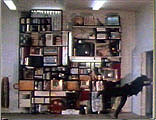<< zurück
 |
Rotraut Pape
D 1984, 44:00
EMAF 1985
Tour:
1985/1986
im Verleih: ja / in distribution: yes
distribution@emaf.de // Tel: 00 49 / (0)541 / 2 16 58
Credits:
16 mm, Farbe, 44:00, BRD 1984. Ein Film von Rotraut Pape. Produktion Rotraut Pape. Musik Holger Hiller. Mitarbeit: Udo Engel, Hermine Huntgeburth, Bettina Semmer, Axel Schaffler, O.H. Hirschbiegel, Michael Schrader, Paul Coerper, Soun-Gui Kim, UdVP.
Beschreibung:
Am Anfang war die Musik. Holger Hiller gab mir vier Musikstücke, die in ihrer Reihenfolge nicht vertauscht werden durften. Der Film durchquert nacheinander diese Musikblöcke.
Die Kontinuität des Ab-Laufs wird dargestellt durch "Die Person", die um ihren neutralen Charakter zu kennzeichnen nicht aus einem Mann besteht, sondern aus vielen: der Anzug wechselt die Köpfe. Gradlinig läuft "die Person" durch den Film, ohne Zeitverlust über Schnittstellen, in denen die Welt klein wird (wenn "die Person" mit ein paar Schritten von Marseille nach Tanger läuft), die Häuser groß werden (wenn "die Person" in Berlin hineingeht, nach hinten aus dem Fenster auf Hongkong blickt), die Zeit verloren geht (wenn es eben nur nieselte, jetzt lange schon geschneit haben muss), in denen also alle Gesetze gebrochen werden, wie ich es sonst nur denken kann.
Description:
In the beginning was the music. Holger Hiller gave me 4 pieces of music, the order of which was not to be changed. The film traverses each of those blocks of music in succession. The continuity of the sequence of events is represented by THE PERSON, who, in order to define its neutral character, does not consist of a single man, but of many. The suit of clothes changes heads. THE PERSON proceeds in a straight line through the film, without loss of time across cuts, in which the world grows small (when THE PERSON passes from Marseille to Tanger in one step); in which the houses grow large, (when THE PERSON enters in Berlin and looks out of a rear window onto Hong Kong); in which time is lost, (when it first rained, and an instant later all is covered with snow): in which all laws I could possibly think of are broken. (R.P.)
Rotraut Pape - whose avant-garde films SOUTERRAIN (1978) and "90°" (1980) were shown in the 'Forum' applies all the cinematographic grammar she has acquired in her new film FLIEGER DÜRFEN KEINE ANGST HABEN, and thereby effortlessly overturns the balance of power. She refuses to follow rules and aesthetic laws of any kind, instead, she makes the material and the form pliable to her own needs. Instead of drawing academic boundaries to exclude or divide off certain areas, in FLIEGER DÜRFEN KEINE ANGST HABEN the world, the media, identity is opened up. The aviator is filled with courage and passion. Borders mean nothing to him, as must be evident to everyone.
The person in this film goes through 33 different identities, if I have counted correctly, and thus undergoes an enviable process of enrichment.
Kai Schirmer (Berlin) ascends the staircase. Three red cars parked in the courtyard are intercut and indicate the distance to ground level and the time to the top. Celeste ABM (Nice) opens the door, Andreas Wollina (Berlin), Guy Lehmann (Hamburg), Oliver Hirschbiegel (Brussels) and Karol Schneeweiß (Hamburg) rummage about in cupboards and drawers in search of an object that proves to be a red thread running through the action, - a torch with a green light. A crime story? Not merely that. The music by Holger Hiller enters and determines the editing of the pictures. In a furious optical - acoustic rhythm the search-operation escalates into an orgy.In low-level flight the film skims across the borders between media (film-music), between categories (experimental - narrative film) and genres (actionfilm, spyfilm, science fiction at the end). The sounds, which are initially wholly of this world, lose themselves in distant galaxies. Concealed energy steams from the interior of many fragments. The laws of causality, continuity, have become obsolete. The TV tower in Hamburg, the World Trade Center in New York and the Eiffel Tower in Paris stand alongside each other. The towers have become an installation for the Pape film. They still stand to this day. The other installations are documented in the film during the process of their destruction. In Hollywood fashion 5 cameras stretch the sensation of a collapsing complex of shelving, bombastically glorified by the music.
FLIEGER DÜRFEN KEINE ANGST HABEN is pleasingly enough an utterly unpathetic filmic performance. The film seeks and indeed finds likeminded people throughout the world, from Hongkong, (which logically enough proceeds to unfold its colorful life just in front of the window of the deserted old mint in Hamburg), to the harbour of Marseilles. The enormous distances between the avant-garde and consumer art, from one medium to another, from one identity to another: the aviator, always on the move feels at home everywhere. That's why he has courage.
Rotraut Pape's Film is present time, pure and simple: now-art.
(Dietrich Kuhlbrodt)
<< zurück